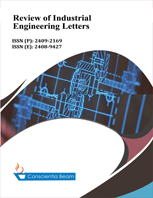Predictive Models for Cutting Force in Turning Tools Based on Response Surface Methodology
DOI:
https://doi.org/10.18488/journal.71/2018.41.1.11Abstract
This paper presents the development of predictive models for feed cutting force component when turning mild steel rods at 90owith cutting tools in a local lathe shop. The predictive models were formulated with cutting condition kept dry. Experimental plan was based on Rotatable Central Composite Design (RCCD) and cutting forces generated in the feed direction was measured using a dynamometer. Analysis was performed on the generated data for both tool-work piece combination and feed rate and its squared effect is found to influence the response variable greatly. However, other factors and their interactions provide secondary contributions. Next, the predicted models were compared with the measured feed cutting forces and an agreement established. The coefficient of determination R2 values of the models gave 76% and 79% respectively, which indicate that the predicted models could adequately describe the process within the conditions that were being studied.

